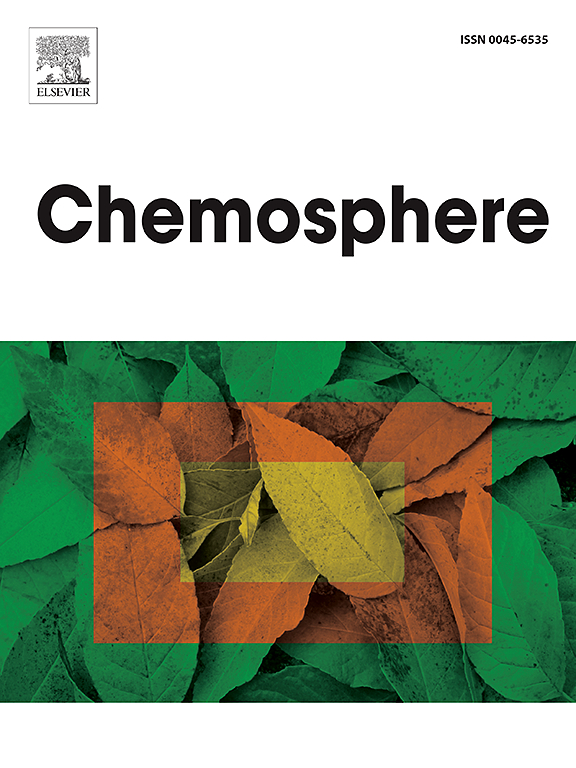艾伯塔省油砂地区社区场所环境颗粒物的氧化电位
IF 8.1
2区 环境科学与生态学
Q1 ENVIRONMENTAL SCIENCES
引用次数: 0
摘要
空气污染是一种主要的环境健康风险,它与世界各地的各种疾病和死亡率有关。细颗粒物(PM)的吸入是空气污染对健康影响的一个重要原因,其潜在机制之一涉及诱导体内氧化应激。油砂开采是加拿大阿尔伯塔省北部的一个主要经济部门,也是一个显著的空气污染源。尽管如此,调查该地区与接触空气污染物有关的潜在健康影响的研究很少。本研究首次采用脱细胞•OH测定法,研究了油砂生产设施附近四个社区站点的细颗粒物(直径2.5 μm)和粗颗粒物(直径2.5 - 10 μm)的氧化电位(OP)。OPOH以细颗粒物为主,平均占所研究颗粒物粒径范围的70%。OPOH最高的地点位于露天矿南部,人口最多,排放源混合,表明油砂和非油砂源的累积效应。然而,与加拿大受交通和工业排放影响的城市场址报告的值相比,OPOH相对较小。OPOH的变化与PM、微量金属和次级无机盐浓度的变化没有统计学意义上的联系,但对于一小部分样品,OPOH与有机碳和钾有关,这表明来自生物质燃烧的活性有机物种的影响。将需要更大的样本量,以便更密切地审查该区域各种OP指标与气溶胶组成和来源之间的联系。这项工作提供了一个概念证明,以支持旨在评估与接触油砂地区空气污染物有关的潜在健康影响的未来研究。本文章由计算机程序翻译,如有差异,请以英文原文为准。

Oxidative potential of ambient particulate matter from community sites in Alberta's oil sands region
Air pollution is a major environmental health risk and it has been associated with various diseases and mortality worldwide. The inhalation of fine particulate matter (PM) is an important cause of health effects from air pollution with one of underlaying mechanisms involving the induction of oxidative stress in the body. Oil sands mining is a major economic sector and a notable source of air pollution in northern Alberta, Canada. Despite this, studies investigating the potential health impacts associated with exposure to air pollutants in the region are rare. For the first time in this work, using an acellular •OH assay, we studied the oxidative potential (OP) of fine (<2.5 μm diameter) and coarse (2.5–10 μm diameter) PM from four community sites in the vicinity of oil sands production facilities. OPOH was found to be dominated by fine PM, which on average accounted for 70 % reactivity of the studied PM size range. The highest OPOH was found at the most populated sites located south of the open pit mines and with mixed emission sources, suggesting a cumulative effect of oil sands and non-oil sands sources. Nevertheless, OPOH was relatively small compared to values reported for urban sites influenced by traffic and industrial emissions in Canada. OPOH variation could not be linked with a statistical significance to changes in the concentrations of PM, trace metals, and secondary inorganic salts but, for a small set of samples, OPOH was associated with organic carbon and potassium, which suggests the influence of reactive organic species from biomass combustion. A larger sample size will be needed in order to examine more closely the links between various OP metrics and the aerosol composition and sources in the region. This work provides a proof of concept to support future studies aimed at assessing potential health impacts associated with exposure to air pollutants in the oil sands region.
求助全文
通过发布文献求助,成功后即可免费获取论文全文。
去求助
来源期刊

Chemosphere
环境科学-环境科学
CiteScore
15.80
自引率
8.00%
发文量
4975
审稿时长
3.4 months
期刊介绍:
Chemosphere, being an international multidisciplinary journal, is dedicated to publishing original communications and review articles on chemicals in the environment. The scope covers a wide range of topics, including the identification, quantification, behavior, fate, toxicology, treatment, and remediation of chemicals in the bio-, hydro-, litho-, and atmosphere, ensuring the broad dissemination of research in this field.
 求助内容:
求助内容: 应助结果提醒方式:
应助结果提醒方式:


